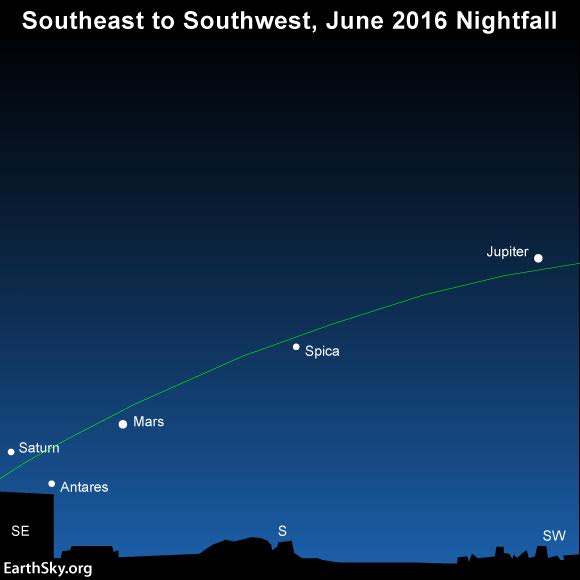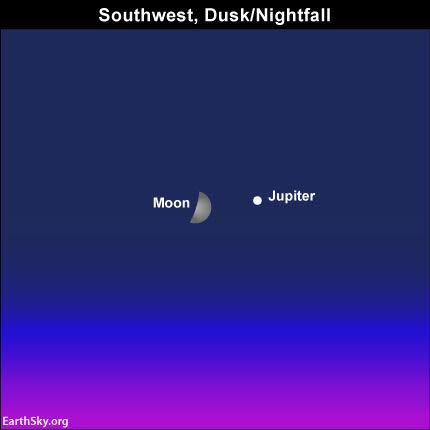Tonight – June 11, 2016 – look for the moon in your sky first thing at evening dusk. That nearby brilliant “star” is the king planet Jupiter. The moon and Jupiter rank as the brightest and second-brightest heavenly bodies to grace the June 2016 evening sky. As dusk ebbs into darkness, also look for nearby Regulus, the brightest star in the constellation Leo the Lion.
The moon has been sweeping past this star and planet for the past several days. If you’ve looked outside at the same time each evening, you might’ve noticed the moon’s eastward motion from one night to another, in front of the fixed star background. This eastward motion of the moon in front of the stars is due to the moon’s own motion in orbit around Earth.
Jupiter is usually the fourth-brightest celestial object to light the heavens, after the sun, moon and Venus. In June of 2016, however, Venus is lost in the sun’s glare, and Jupiter reigns over the evening sky … if you don’t count the moon.
If you’ve looked, though, you know there’s another planet, shining almost as brilliantly as Jupiter. This other bright world is lighting up the eastern sky at nightfall. It’s the dazzling red planet Mars.
We passed between the sun and Mars on May 22. Mars was closest to us on May 30. So Mars’ brightness is now waning again, but, still, the red planet is very bright and noticeably reddish in color.
In fact, because it’s so bright and noticeable, you can use Mars to find two other bright lights (though dimer than Mars). They are the ringed planet Saturn and red star Antares, sometimes called the Heart of the Scorpion in the constellation Scorpius.
Of these three objects, Mars is brightest, then Saturn, then Antares. You can also distinguish Saturn from Antares by color. Saturn appears golden, while Antares exhibits a ruddy hue, not unlike that of Mars. In fact, the name Antares (Ant-ares) is said to stem from its red color, which sometimes rivals that of Mars (Ares is the Greek name for the Roman war god, Mars).
But Antares is nowhere near as bright as Mars in June 2016.
Very rarely, Mars can outshine Jupiter in the nighttime sky. Mars will come close enough to Earth during its opposition in July 2018 for Mars to become the fourth-brightest celestial object after the sun, moon and Venus.
At other times, though, Mars can appear fainter than Saturn, and be no brighter than a rather inconspicuous star in the nighttime sky. The brightness of Mars varies greatly, because it’s a rocky world whose relative distance from Earth changes more greatly than that of the more distant gas giants, Jupiter and Saturn.
Saturn’s brightness varies more than that of Jupiter, because of the changing aspect of Saturn’s rings. When the rings tilt our way, Saturn appears brighter in Earth’s sky; and when we view the rings edge-on, Saturn appears dimmer.
Meanwhile, Jupiter’s brightness doesn’t vary as much as Saturn’s. Jupiter at its dimmest can never appear as faint as Saturn at its brightest. Nor can Saturn at its faintest ever become as dim as Mars at its faintest. Enjoy the red planet Mars now as it boldly lights up the starry sky.
Want to know more about the maximum and minimum brightness of the planets? Click here.

Bottom line: As soon as darkness falls on June 11, 2016, you’ll see the moon shining close to Jupiter. Also, look for Mars, Saturn and Antares to make up a bright triangle of lights in your eastern sky.













